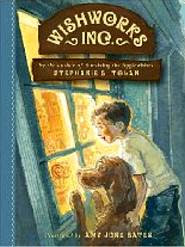
The buzz-cut kid was coming out of the boys' room with an evil grin on his face. The halls were empty. Max found his lunch box in the toilet.
He wouldn't be able to eat his apple. His sandwich was in a zip-lock bag. Ziplocks were supposed to keep water out. Even so, he knew he couldn't make himself eat the sandwich now. What made him maddest was the butterscotch brownie his mother had let him take. It was the last one. Max had almost eaten it on the school bus. He wished now that he had.
He opened the lunch box and emptied everything into the trash.
Max has to begin third grade in a new school, in a cramped new apartment in a whole new neighborhood, and now he's got to face bully Nick Berger every morning before school. He has reasons "not to be crazy about real," to wish he were somewhere else, and for that he's got
Adventure Time.
Adventure Time is Max's escape into his own world where he has a big, plume-tailed dog named King with whom he shares amazing adventures in which he is always the hero. Max has always been able to tailor his daydreams exactly as he pleases, but one day his reverie takes a new turn. Max finds himself at the counter of an intriguing little shop called
Wishworks, Inc., where the little white-haired proprietor encourages him to wish for anything he wants. "WISHES GUARANTEED," the sign says.
"This is the hard part," the man said. "Think very carefully before you answer. Very carefully. What's your wish?"
Max knows what he wants. He wants a big, beautiful dog like King, a dog that will sleep with him every night, have wonderful adventures with him, and keep bullies like Nick at bay.
"I wish for a real dog," Max says.
And that's when "real" sets in. In short order Max sees his mother, who has always nixed the idea of a dog, adopting an ugly little yellowish puppy, with a skinny, rat-like tail, a genuinely ugly little mutt which commandeers most of his bed, barks in an annoying high-pitched yap, and which Max must walk and feed twice a day. His mother and little sister fall in love with the little yapper right away, and Max can't believe his wish could turn out so badly. "Ratty" is REAL, all right, Max thinks as he walks her in the chilly rain, pooper scooper and plastic bag in hand, but she's NOT the dog he wished for.
But when Max returns to
Wishworks, Inc., to try to fix his wish gone wrong, things go from bad to worse.
"I need customer service. I need refunds and exchanges," he tells the elderly shop owner firmly.
And Max buys another wish, a wish that Ratty would disappear, and when he returns home, he learns that indeed the little mutt has escaped from his sister and can't be found anywhere in the neighborhood. But in true wish fulfillment fantasy tradition, Max soon learns that, having gotten his wish, he really doesn't want it. His mom and sister grieve for their missing puppy, and after having had a
real dog, an unpredictable, messy, and definitely uniquely
real dog, Max finds that his fantasy dog King is downright boring. The question for Max is whether he can make the right wish this time, the one which will make them all happy.
Stephanie Tolan's
Wishworks, Inc.
is a tantalizing look at the old theme of being careful what you wish for, crafted realistically and skillfully for the early independent reader. Tolan, winner of the
Newbery Honor Award for her acclaimed
Surviving the Applewhites
and the
Christopher Award for her sensitive story of a girl and an abandoned dog,
Listen!
reviewed
here, knows how to craft a story well for her targeted audience, and this short novel fits perfectly into the niche between beginning chapter books and the full-fledged junior novel genre. Funny, poignant, and satisfying, it should find its place with many young readers.
Labels: Dog Stories, Fantasy (Grades 2-4)
















